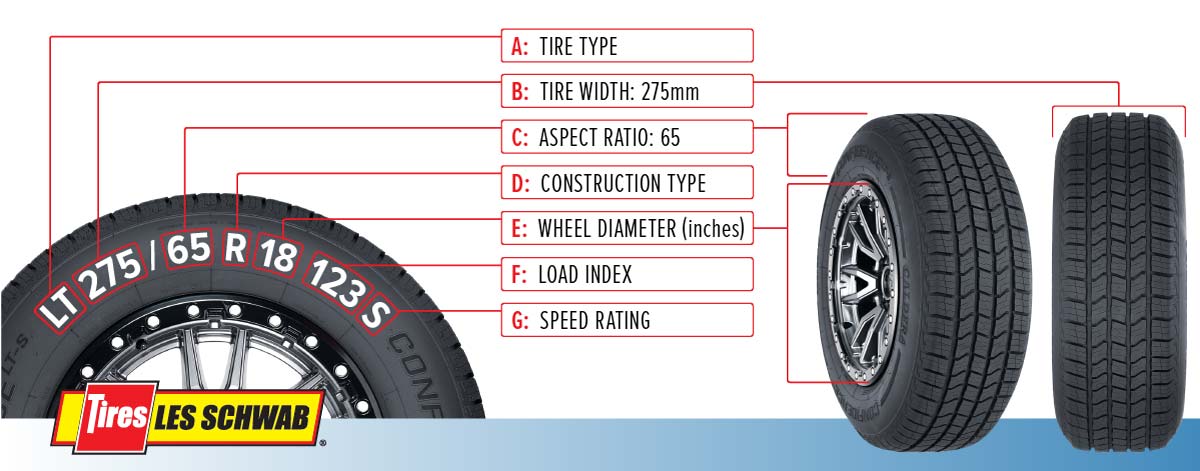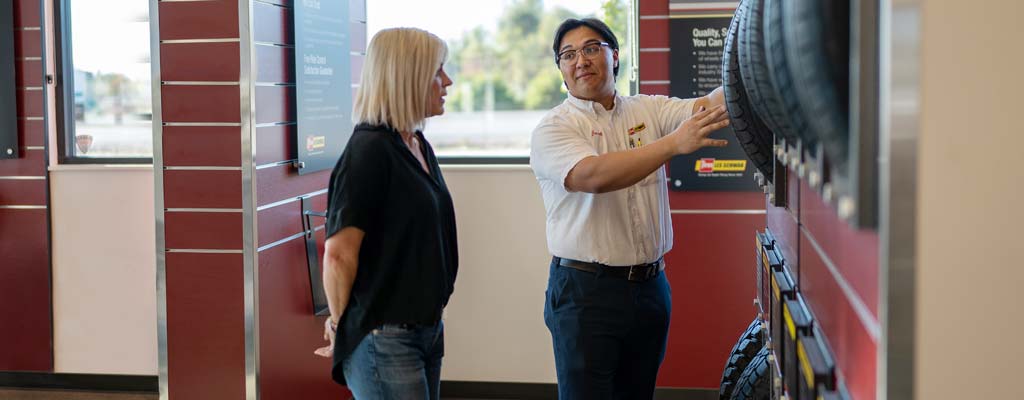How to Buy: All-Terrain Tires
Finding the best all-terrain (A/T) tires for your vehicle starts by knowing what A/T tires are and what makes them special. We’ve put together some quick advice to help you get the right A/T tires for your SUV, CUV or light truck, including what makes A/T tires unique, when to choose them over mud tires, where they work best, and what to consider when shopping for a set of A/T tires.
What you’ll find in this guide:
What To Know Before Buying All-Terrain Tires
Along with the added traction, all-terrain tires give your SUV, CUV or light truck a more aggressive look. Beyond that hard-hitting appearance, these tires are designed for the highway, local commutes, gravel roads, some off-roading, and most weather conditions, including light snow. Some all-terrain tires are severe snow-rated (three-peak mountain snowflake (3PMS)), which qualifies them as a winter traction tire for mountain pass restrictions.
Find the right A/T tires for your vehicle at Les Schwab.
How Are All-Terrain Tires Different from Other Tires?
For starters, all-terrain tires are a solid mix of some impressive tire technology, including the benefits of highway tires (H/T) and mud tires (M/T). Overall, A/T tires are ideal for daily driving, most weather conditions, as well as gravel and dirt roads.
What really sets them apart are their year-round usability, open tread pattern, and sidewall support. Thanks to broader channels between tread blocks, you’ll get more traction. Plus, the sidewalls offer extra reinforcement to help support heavier loads. That can come in handy when you’ve loaded the back of your truck down with camping equipment, work gear, or gravel for the yard. A/T tires can also be a nice addition to larger, heavier trailers.
Why Choose An All-Terrain Over A Mud-Terrain Tire?
M/T tires are traction beasts designed to chew up the deepest, slickest, wet clay and impassable muck. They give you more control in unpredictable conditions and challenging terrain. However, mud-terrain or M/T tires are not ideal for highway driving, daily commutes, packed snow, or ice. That’s what makes A/T tires so popular with SUV, CUV and light truck owners. Like M/T tires, A/T tires help you navigate some sand, dirt, gravel, and rock, but they are also built for daily driving.
Where Do All-Terrain Tires Work Best?
A/T tires are designed specifically for SUV, CUV and light truck owners who tackle pavement more often than gravel or dirt roads. Essentially, they’re perfect for almost anywhere in the West.
All A/T tires are all-season capable. When you do face offroad conditions or less-than-ideal weather, A/T tires will perform, giving you the right amount of traction when you need it most. Similar to all-season tires, A/T tires do their job without sacrificing much in the way of fuel efficiency or ride comfort. Learn more about choosing the right off-road tires.
Understanding an All-Terrain Tire Sidewall
Look at the side of any A/T tire and you’ll notice a set of numbers and letters. These codes are there to help you understand a tire’s advantages and limitations. Here’s a quick look at what each of those digits indicate. For a more detailed look, see Tire Size Explained.

A: Tire Type:
The first letter in the code tells you what class of tire it is. P stands for passenger vehicle tire, LT means light truck, and ST stands for special trailer. If there’s no letter before the first number, you have a metric tire most commonly referred to as European size.
B: Tire Width:
The three-digit number following the letter is the tire’s width (from side to side, looking at the tire head-on).
C: Aspect Ratio:
The forward slash separates the tire width number from the two-digit aspect ratio. The aspect ratio is the height of the sidewall divided by the width of the tire. The bigger the aspect ratio, the higher/taller the tire’s sidewall or profile will be in relation to the tire width. For more information about aspect ratio and sidewalls, see Tire Size Explained.
D: Construction Type:
This single letter indicates the internal construction of the tire. R stands for radial tires, while D indicates tires built with diagonal (crisscrossed) plies. These are sometimes called bias-constructed tires.
E: Wheel Diameter:
This two-digit number specifies wheel diameter in inches. It’s the distance between the two bead seat areas. This is where a tire gets tightly sealed onto the wheel.
F: Load Index:
Is a two-digit or three-digit number that specifies tire load index, or how much weight a tire can support. Get more information about tire load index.
G: Speed Rating:
This indicates the top safe speed for a sustained amount of time. A tire with a higher speed rating can handle heat better and provide more control at faster speeds.
What to Consider When Purchasing A/T Tires
Comparing tire options can get complicated. Thankfully, the pros at Les Schwab understand the importance of these numbers and letters and can help you find the right tires for your needs. Do you want added tire life and fuel economy? Or do you need more traction for specific conditions or towing capability? When looking at a set of A/T tires, here are some of the things to consider.
Where you live.
Geography and weather conditions are close cousins. If you drive an SUV, CUV or light truck and regularly face some light snow and travel on gravel as well as paved roads, consider A/T tires.
What you do for work and fun.
Work truck owners as well as camping or outdoor enthusiasts, including those who tow a camper or trailer, might consider A/T tires for their ruggedness and load carrying capacity.
What you drive.
If you drive a compact vehicle, A/T tires might not be available or the best choice. But for SUV, CUV, and light truck owners, A/T tires can be ideal. Especially when those tires will travel on highways as well as less-maintained roads, including road conditions caused by adverse weather.
Tire mileage.
A/T tires are well-known for ride comfort, added traction, load carrying capacity, rugged good looks, and overall good tire life. While you might not get as many miles out of a set of A/T tires as you would highway tires, the added benefits of A/T tires can offset the overall expected miles.
3-Peak Mountain Snowflake (3PMS) Rating.
This symbol means the tires have been tested and certified to perform in winter conditions. A/T tires that meet the testing criteria will have this symbol on the sidewall. While it’s best to have a set of winter tires to navigate severe snow and ice, the 3PMS symbol does indicate a tire can face some winter conditions.
Best All-Terrain Tires for Daily Driving
You’ll find the perfect all-terrain tires for your driving needs at Les Schwab. Our pros can help you choose the right ones, whether you do a lot of camping, simply want to give your ride a more aggressive look, or plan to tackle plenty of gravel and dirt roads.
-

- Open Range A/T
-

- Pinza AT
-

- Back Country A/T2

